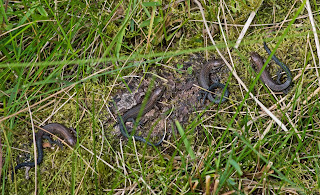Baby lizard boom in the Belfast Hills
A baby boom has been reported in the Belfast Hills this summer - and the infants aren’t birds or mammals, but lizards.
Most people don’t realise that there are common lizards in Ireland, but it’s a little known fact that they can be found throughout the Belfast Hills, from Cave Hill to Divis and Black Mountain.
Last week, surveyor Philip McErlean of Ecotrak NI discovered an incredible 40 common lizards in a three-hour search of Ulster Wildlife’s Slievenacloy Nature Reserve - 16 of them newborns.
The lizards give birth to live young instead of laying eggs and Philip says he spotted lots of little dark coloured newborns basking in the warmth earlier this week.
He says it was a huge improvement on last year’s tally when the poor spring and summer weather contributed to a huge drop in the birth rate.
Over the past five years, Philip has discovered populations of lizards living across the Belfast HIlls, at Divis/Black Mountain, Cave Hill Limestone Quarry and Ballyaghagan.
“Common or 'viviparous' lizards have adapted to survive in our cool climate and one such adaptation is that they hatch their eggs internally and give birth to live young in late summer,” Philip said.
“So at this time of year there is a great boost to numbers, with lots of little dark-coloured, baby lizards.
“This partly accounts for the large number seen on the recent visit to Slievenacloy - 16 newborns out of 40 lizards seen. Having said that, 16 newborn lizards is a great improvement on last year when the poor spring and summer weather contributed to a huge drop in the birth rate.
“Unfortunately the boost in numbers is probably a temporary feature as newborn lizards provide food for birds and other creatures. It has been estimated that more than 90% fail to make it through the first year.”
Philip says Slievenacloy is an ideal place to spot lizards as it is a relatively small area, close to the road and has a good network of paths.
“It is also unique in that some of the field margins and paths are fenced off providing corridors of rough grass and open sunny banks which are protected from grazing. This provides an ideal habitat and a good supply of invertebrates such as spiders, flies, worms and moths for the lizards to eat,” he said.
Philip says he took up lizard surveying as a hobby in 2011 after retiring from an administrative post in the Health Service.
“In fact I had spent most of my life blissfully unaware that they even existed in Ireland until I saw one on a visit to the Giant's Causeway in 2008,” he said.
“My first survey at Divis/Black Mountain in the spring of 2011 was more in hope than expectation but did uncover a good population of Common Lizards.
“Slievenacloy was the next survey, in the late summer of 2011. It took several weeks and numerous visits before one lizard was discovered but gradually the number of sightings increased as I became more aware of the preferred habitat at that site.
“The survey was curtailed as October approached and the lizards began to go into hibernation for the winter.
“Subsequent surveys have uncovered lizard populations at Cave Hill Limestone Quarry and Ballyaghagan and I have continued to monitor the population at Slievenacloy.”
The species is a protected one in Northern Ireland and is greatly threatened by loss of habitat,” he said.
“In the Belfast Hills, the greatest threats are wildfires, scrub encroachment and overgrazing.
“I am pleased to see that conservation organisations such as Ulster Wildlife and the Belfast Hills Partnership are increasing awareness of this not so 'common' lizard and are considering measures to protect its habitat and increase connectivity.”





Comments
Post a Comment